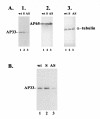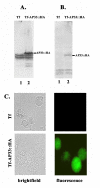Antisense RNA decreases AP33 gene expression and cytoadherence by T. vaginalis
- PMID: 17608941
- PMCID: PMC1929106
- DOI: 10.1186/1471-2180-7-64
Antisense RNA decreases AP33 gene expression and cytoadherence by T. vaginalis
Abstract
Background: Host parasitism by Trichomonas vaginalis is complex. Adherence to vaginal epithelial cells (VECs) is mediated by surface proteins. We showed before that antisense down-regulation of expression of adhesin AP65 decreased amounts of protein, which lowered levels of T. vaginalis adherence to VECs. We now perform antisense down-regulation of expression of the ap33 gene to evaluate and confirm a role for AP33 in adherence by T. vaginalis. We also used an established transfection system for heterologous expression of AP33 in T. foetus as an additional confirmatory approach.
Results: We successfully select stable trichomonads with sense (S) and antisense (AS) plasmids. RT-PCR confirmed decreased amounts of ap33 mRNA in AS-transfected parasites, and decreased amounts of AP33 had no effect on growth and viability when compared to wild-type (wt) trichomonads. Immunoblots of proteins from AS-transfectants gave significant decreased amounts of functional AP33 capable of binding to host cells compared to wt- and S-transfected trichomonads. As expected, AS-transfectants had lower levels of adherence to VECs, which was related to reduction in surface expression of AP33. Stable expression of T. vaginalis AP33::HA fusion in T. foetus was confirmed by immunoblots and fluorescence. The episomally-expressed surface AP33::HA fusion increased adherence of trichomonads to human VECs, which was abrogated with anti-AP33 serum.
Conclusion: These results using both antisense inhibition of gene expression and AP33 synthesis and the heterologous expression of AP33 in T. foetus confirms a role for this protein as an adhesin in T. vaginalis.
Figures







References
-
- Health Organization three hundred, thirty-three million new, STD curable cases in 1995. AIDS Wkly. 1995. pp. 15–16. - PubMed
-
- World Health Organization . Global Prevalence and Incidence of Selected Curable Sexually Transmitted Infections. Overview and Estimates. WHO, Geneva, Switzerland; 2001.
-
- Cotch MF, Pastorek JG, 2nd, Nugent RP, Hillier SL, Gibbs RS, Martin DH, Eschenbach DA, Edelman R, Carey JC, Regan JA. Trichomonas vaginalis associated with low birth weight and preterm delivery. The Vaginal Infections and Prematurity Study Group. Sex Transm Dis. 1997;24:353–360. doi: 10.1097/00007435-199707000-00008. - DOI - PubMed
Publication types
MeSH terms
Substances
Associated data
- Actions
- Actions
- Actions
- Actions
- Actions
- Actions
- Actions
- Actions
- Actions
- Actions
Grants and funding
LinkOut - more resources
Full Text Sources
Research Materials

